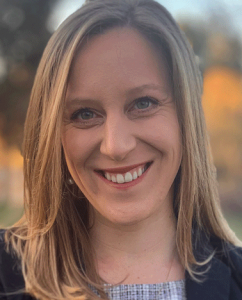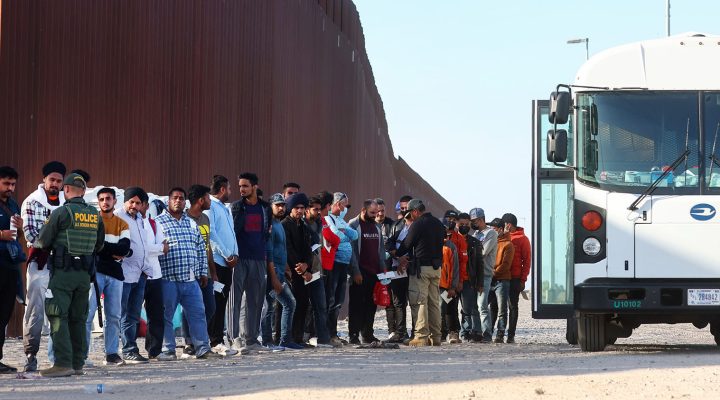Republicans in Congress are mistaken in believing harsh asylum policies will stem the tide of migrants swelling at the Southern border in search of refuge in the United States, a panel of immigration experts said.
It is equally wrong to assume robust and humane immigration policies attract higher numbers of migrants fleeing violence and poverty to the U.S, said Chelsea Sachau, managing attorney for the Florence Immigrant and Refugee Rights Project.

Chelsea Sachau
“This is not an ‘If you build it, they will come’ situation. Asylum seekers will keep coming because they have no other option, so we must build it,” Sachau said during a Nov. 28 webinar hosted by the #WelcomewithDignity campaign.
The panel discussion identified current deficiencies in American asylum practices, warned against the efforts in Congress to effectively end asylum, and to suggest ways federal, state and local governments can re-establish a welcoming asylum system.
The solution has to begin with President Joe Biden, said Azadeh Erfani, senior policy analyst for the National Immigrant Justice Center.
“The Biden administration has taken a number of measures that endanger the rights of asylum seekers,” she said. “That has included the implementation of a new asylum ban that mirrors the unlawful policy of his predecessor.”
The White House has revived the Trump administration practice of forcing asylum seekers in Border Patrol custody to undergo rapid screenings to determine the credibility of their fear of reprisals in their native countries. A negative determination results in a denial of asylum, she said.

Azadeh Erfani
Asylum seekers also are required to prove they sought refuge in other countries they traveled through en route to the U.S.
“The administration has also come up with its own punitive and unnecessary barriers to the right to asylum such as subjecting families to heightened surveillance and expedited fear screenings and turning away asylum seekers who aren’t able to secure an appointment under CBP One, a highly dysfunctional mobile app that is largely inaccessible to many asylum seekers due to literacy barriers, to technological barriers and to financial barriers,” Erfani explained.
As a result, harm has been inflicted on asylum seekers and on America’s reputation as a welcoming refuge for those in danger, she continued. “These policies, the asylum ban and the rapid fear screenings, have already led to the violation of the rights of people who are seeking refuge in the United States under domestic and international law.”
Other developments have been just as alarming, said Erika Pinheiro, executive director of Al Otro Lado. “Due to the large number of individuals who are crossing between ports of entry along the California border, Border Patrol has decided to hold thousands of migrants in open-air detention sites. There are seven currently along the California border between San Diego and the high desert.”
Asylum seekers are detained in those centers up to four days at a time without adequate food, water, shelter and sanitary facilities, she said. Aid groups provide most of the needs for those incarcerated in the camps.

Erika Pinheiro
From the camps, asylum seekers are released onto the streets of San Diego, where shelters and other resources once provided by California are no longer available, Pinheiro said.
“Now that it’s a much more chaotic situation, we are unfortunately seeing a large number of family separations occurring between processing from open-air detention sites to street release. We’ve documented over 900 separations of family groups between Sept. 20 and today. We are also seeing a significant number of individuals being separated from their families and sent to ICE detention facilities as far away as Louisiana or Texas. And again, this is largely the result of state funding cuts to respite shelters.”
The current asylum system is baffling to most migrants, including those waiting in Mexico, as they use the CBP One app to schedule hearings in the U.S., Sachau said.
“Border wide, there are less than 1,500 CBP One appointment slots available per day, and there are thousands of people who are attempting to use the CBP One app every day,” she said. “Some people will tell me that they’ve been trying for as many as four to six months, but then they see other people who have just arrived and are able to secure an appointment within a few days or weeks.”
Additionally, there are constant technical glitches with the app, she added. “The U.S. government has completely made seeking asylum at a port of entry really a lottery system, which is contrary to our law.”
Conservatives in Congress, meanwhile, are seeking to codify the asylum-deterring practices implemented by both the Trump and Biden administrations, Erfani said. “As we speak, Congress is contemplating inserting a number of anti-asylum changes into legislation and funding bills that would basically make it even worse for people to seek protection in the United States.”
Drawn from the Secure Border Act of 2023, which passed the Republican-controlled House in May, the provisions under consideration include heightening eligibility standards to pass credible fear tests, reviving Trump’s “Remain in Mexico” policy, expanding detention practices and capacities, increasing child and family detention and restricting the use of temporary humanitarian parole.
“These policy changes would further violate U.S. obligations under the Refugee Convention and the Refugee Protocol,” Erfani said. “It would significantly undermine people’s rights to due process and fair adjudications of their claims. And it would contribute to the unprecedented mass displacement that we see today in the world as well as at the Southern border.”
Solutions the panel offered included an across-the-board appeal that Biden reverse course on immigration. “Minimally, rescind the asylum ban. It’s not only unlawful, but it’s already been proven to be ineffective and unfair since most people don’t know about it before it applies to them,” Sachau said.
Another fix would be to end unlawful detentions at the border, Pinheiro said. “Border Patrol needs to immediately end the practice of holding migrants in open air detention facilities and bring asylum seekers indoors for processing and adhere to their own detention standards.”


